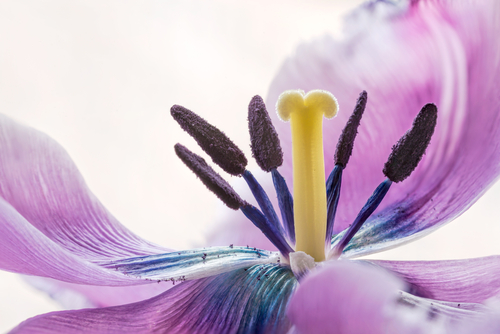
Step into the Beautiful World of Flower Anatomy
Whether you enjoy them in a garden or a bouquet, flowers spread joy, gratitude, and romance around the world (not to mention plenty of delicious fruit and veggies!). But what gives them such a diverse and beautiful appearance? Understanding flower anatomy can give us a clue into why flowers dazzle our world in color!
Flowering Plants
Not all plants have flowers. In fact, most groups of vascular plants don’t, using cones to bear seeds or reproducing with spores. By geological time, flowers are new to the plant world. They only showed up around 145 million years ago, during the Cretaceous period. Once they bloomed, however, the world committed to florals. Perhaps due to their smaller genomes and greater photosynthetic capacity, angiosperms took over the plant world. Today, over 350,000 species of angiosperms blossom around the world.

The Parts of a Flower
As a whole, the flower is the reproductive structure of a plant. However, flower anatomy divides into two categories: the vegetative parts and the reproductive parts. The vegetative part of the flower provides the basic structure of the flower and the aesthetic appeal that attracts pollinators. In contrast, the reproductive parts include the organs involved in reproduction.
Vegetative Flower Anatomy
The vegetative parts of a flower are really what give flowers their hype. Endless varieties of colors, shapes, and smells create a seemingly infinite bouquet of flower types. Below are the vegetative elements of a flower including the supportive peduncle and pedicel as well as the decorative petals and protective sepals.
The Support System
- Peduncle: A silly name for a simple thing, the peduncle refers to the stalk or stem of the whole flower or inflorescence (e.g. a rose stem).
- Pedicel: Sometimes confused with the peduncle, a pedicel is a mini stem that connects the individual flowers of a grouped inflorescence. For example, pedicels connect the mini flowers of a hydrangea into their characteristic clumps. The peduncle still supports the entire inflorescence.

The Floral Envelope
- Petals: Obvious on many flowers due to their vibrant colors, the petals are modified leaves that serve to attract pollinators. Lucky for us, bees and butterflies have exquisite taste, and our bouquets also benefit from the beauty of flower petals. Collectively, the petals are known as the corolla.
- Sepals: Similar in form to the petals, the sepals are often green instead of colored. Additionally, the sepals encase the bud of the flower, enclosing the petals before the flower blooms. As a group, the sepals form the flower’s calyx.
- Receptacle: The receptacle marks the spot where the petals and sepals come together at the base of the flower. Additionally, the petals and sepals combined create the floral envelope, also called the perianth.
Why Do Flowers Smell Good?
Ever stop and smell the roses? Flower scents come from oils found inside the petals of a flower! Some flowers have just a handful of compounds that make up their specific scent, though some orchids have developed a complex cocktail of over 100 different chemicals!
Reproductive Flower Anatomy
While the structure of specific flowers varies, all flowers have the same general parts including the stamen, anther, and pistils. When a bloom has both the male and female parts, it is considered a perfect flower, like a rose or tulip. On the other hand, an imperfect flower only has one or the other. There are both male and female squash blossoms, for example. The female squash flower only has a pistil while the male flower has a pollen-covered anther.
Parts of the Stamen
Surrounding the pistil of a perfect flower are the stamens. The number of stamens varies among the flower species. Lilies, for example, may just have a few stamens while some cactus flowers have dozens. The stamen is the male part of the flower and has two parts: the filament and the anther.
- Filament: Needing to stand tall to be accessible to the pollinators buzzing by, the filament is the thin stalk of the stamen.
- Anther: Perched at the top of the stamen, the anther produces the pollen.

Parts of the Pistil
Located in the center of the flower stands the pistil. Coincidentally, the pistil’s shape is reminiscent of a flower vase with a bulbous bottom, slim neck, and notable lip. Each of these different parts has its own function in the process of fertilization. Together, the stigma, style, and ovary make up the female part of the flower.
- Stigma: At the top of the pistil, the stigma receives the pollen.
- Style: The style connects the ovary to the stigma with a tube-like structure. Once the stigma receives pollen grains, the style acts as the bouncer for the flower. When a pollinator drops pollen onto the stigma, the pollen tries to connect with the ovules by growing a pollen tube. However, the style only allows pollen tubes from the same plant species to pass, weeding out the riffraff.
- Ovary: The ovary is positioned at the base of the pistil. Just like in animals, the ovary houses the ovules. Once after pollination, the fertilized ovules become the seeds of the plant.
Understanding Flower Anatomy
Knowing the names and purposes of specific flower parts is delightful in itself, but learning flower anatomy has further value. When learning to identify specific flowering plants, you will find that keys and guidebooks are swimming in terminology. Now that you are a flower anatomy expert, you won’t be deterred!
Check us out on EarthSnap, a free app brought to you by Eric Ralls and Earth.com.












